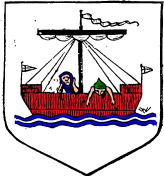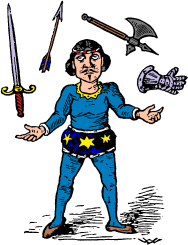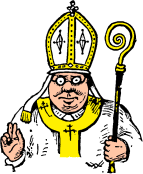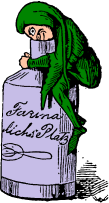HOME
Preface
Introduction
1
2
3
4
5
6
7
8
9
10
11
12
13
14
15
16
17
18
19
20
21
22
23
XII
CHAPTER XII.
OF ARTIFICIAL FIGURES.
HE next selection of Heraldic articles we shall present to our readers are the Artificial Figures, and though, as a rule, we object to artifices of all kinds, yet in Heraldry we have to do violence to our feelings and deal with them.
Artificial figures are of various kinds. There is our maiden aunt, whose money we hope to inherit some day, and who, under the circumstances, displays a tenacity of life which is positively dishonest; we reckon her as an absolutely artificial figure when we contemplate her false teeth, hair, eyebrows, and padding in proportion. Modesty, of which we have an overwhelming quantity, forbids us even to guess to what extent the latter adjunct to beauty obtains with her, though we have a suspicion, we might almost say a certainty, that were that aged damsel to appear as nature made her, she would not only be unrecognizable, but also in danger of being disposed of on the spot for old bones.
Another class of artificial figures we frequently read of are those used by accountants of public companies to delude the unfortunate shareholders into a belief of prosperity, whereas the winding-up process is what they properly require. And here we would make a digression in reference to public companies. And at the same time we would just throw out a conundrum for the benefit of those of our readers who may be desirous of reproducing it in select society, or in quires and places where they sing, or anywhere else where they think it would fit in well. It is this:--What is the difference between a public company and a watch?
Do you give it up--Gentle Reader? * You do! We see it in your expressive eye--your mind's eye. Mark ye ! List, list--oh, list!
* This phrase is copyright; anyone using it without permission of the publisher will be prosecuted according to law.
The company stops by winding up--the watch goes on.
Go--on--ahead.
Neither of these kinds of artificial figures, however prevalent in real life, are found in Heraldry, but instead of them we have, as might be expected, swords, which are said sometimes to be "erect" or "pommelled:" the non-Heraldic mind would naturally suppose that when it came to a rough-andtumble fight the men and not the swords were pommelled. Occasionally, also, they are "hilted," the hilt thus forming a handle, enabling us to grasp the fact. Sometimes arrows appeared as charges, which of course afforded shafts for ridicule and rudimentary jokes about an arrow mind. They were said to be "armed" or "feathered," according as they appeared pointed or otherwise.
Gauntlets, battle-axes, spears, battering-rams, and pole-axes we simply mention, declining to be struck by them.
Next we come to the Ornamental Figures in contradistinction to the useful, which latter are but seldom to be found in Heraldry. Among the Ornamental Figures are Crowns and Coronets, which belong to the arms, though we might more properly say to the heads, of kings and lords.
Bishops, again, display the might of the Church by bearing a mitre; nor have we any right to throw doubt on the validity of the episcopal appointment by saying of one of those clerical peers that he is a bishop with a hook, because in his arms appears a pastoral crook.
In addition to these artificial flowers of Heraldry, we must also take down a few bricks from architecture to serve as common charges, such as towers, castles, arches, battlements, churches, portcullises, &c., &c. These last were a species of addition to castle gates, which kept out invaders in toto, by being dropped upon their toes.
Navigation also furnishes a few charges to Heralds as well as to underwriters of the present day. Thus sailors who have to see fair and also foul weather on the briny deep, had ships assigned to them, and anchors. These last are also emblems of hope; though why, except it be to denote that what we hope for is often obtained by a fluke, we are unable to state with any certainty.
To recount, however, all the artificial figures which are or may be used in Heraldry would be a perfectly endless task, seeing that the list may be made to comprise vegetables, snuff-boxes, flowers, jampots, boot-jacks, compound rhubarb pills, steam-engines, pickled walnuts, garden-rollers, patent knife-cleaning machines, violins, batter puddings, balloons, tinder boxes, stewed oysters, baby jumpers, dress improvers, hot sausages, 81-ton guns, Revalenta Arabica, opera boxes, eye-openers, post-cards from Mr. Gladstone, blacking bottles, and in fact anything which the hand of man is able to fabricate or his head to imagine.
XII
1
2
3
4
5
6
7
8
9
10
11
12
13
14
15
16
17
18
19
20
21
22
23
Preface
Introduction
HOME
Build: 2019/04/20 14:20:08.59+0900(JST)





